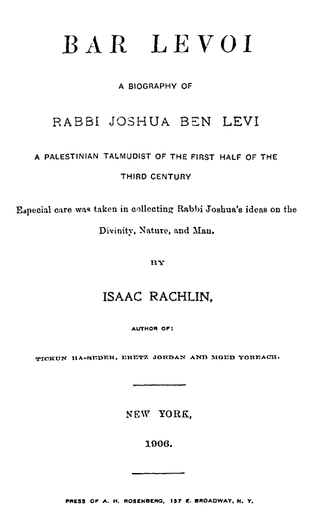Related Research Articles
Amoraim refers to Jewish scholars of the period from about 200 to 500 CE, who "said" or "told over" the teachings of the Oral Torah. They were primarily located in Babylonia and the Land of Israel. Their legal discussions and debates were eventually codified in the Gemara. The Amoraim followed the Tannaim in the sequence of ancient Jewish scholars. The Tannaim were direct transmitters of uncodified oral tradition; the Amoraim expounded upon and clarified the oral law after its initial codification.

Shimon bar Yochai or Shimon ben Yochai, also known by the acronym Rashbi, was a 2nd-century tanna or sage of the period of Roman Judaea and early Syria Palaestina. He was one of the most eminent disciples of Rabbi Akiva. The Zohar, a 13th-century foundational work of Kabbalah, is ascribed to him by Kabbalistic tradition, but this claim is universally rejected by modern scholars.

The exilarch was the leader of the Jewish community in Mesopotamia during the era of the Parthians, Sasanians and Abbasid Caliphate up until the Mongol invasion of Baghdad in 1258, with intermittent gaps due to ongoing political developments. The exilarch was regarded by the Jewish community as the royal heir of the House of David and held a place of prominence as both a rabbinical authority and as a noble within the Persian and Arab court.
Rabbah bar Naḥmani was a Jewish Talmudist known throughout the Talmud simply as Rabbah. He was a third-generation amora who lived in Sassanian Babylonia.

Abba ben Joseph bar Ḥama, who is exclusively referred to in the Talmud by the name Rava, was a Babylonian rabbi who belonged to the fourth generation of amoraim. He is known for his debates with Abaye, and is one of the most often cited rabbis in the Talmud.
Rav Pappa was a Babylonian rabbi, of the fifth generation of amoraim.
Ulla or 'Ulla was a Jewish Talmudist and one of the leading Halakhic amoraim in the Land of Israel during the late 3rd and early 4th centuries CE. Together with rabbis Avin and Dimi, Ulla was in close contact with Babylonian centres of Torah study.

Rav Huna was a Jewish Talmudist and Exilarch who lived in Babylonia, known as an amora of the second generation and head of the Academy of Sura; he was born about 216 CE and died in 296–297 CE or in 290 CE.
Rav Ḥisda was a Jewish Talmudist who lived in Kafri, Asoristan in Lower Mesopotamia near what is now the city of Najaf, Iraq. He was an amora of the third generation, and is mentioned frequently in the Talmud.
Jose ben Helpetha, commonly known as Jose ben Halafta (IPA:) was a tanna of the fourth generation. He is the fifth-most-frequently mentioned sage in the Mishnah. Yose Ben Halafta is the one of two rabbis called Rabbi Yose in the Talmud; the other being Jose ben Zimra, an amora.
Adda bar Ahavah or Adda bar Ahabah is the name of two Jewish rabbis and Talmudic scholars, known as Amoraim, who lived in Lower Mesopotamia, a region known in Jewish texts as "Babylonia".

Joshua ben Levi was an amora, a scholar of the Talmud, who lived in the Land of Israel in the first half of the third century. He lived and taught in the city of Lod. He was an elder contemporary of Johanan bar Nappaha and Resh Lakish, who presided over the school in Tiberias. With Johanan bar Nappaha, he often engaged in homiletic exegetical discussions.
Rav Sheshet was a amora of the third generation of the Talmudic academies in Babylonia. His name is sometimes read Shishat or Bar Shishat.
Rav Nachman bar Yitzchak was a Babylonian rabbi, of the fourth and fifth generations of amoraim.
Amemar was a Babylonian rabbi of the fifth and sixth generation of amoraim. His name is a compound word formed from the personal name Ammi and the title Mar "master".
Huna ben Joshua was a Babylonian rabbi, of the fifth generation of amoraim.
Rav Idi bar Abin Naggara was a Jewish Babylonian rabbi who lived around 350 CE.
Jeremiah bar Abba was a Babylonian rabbi who lived around the mid-3rd century. He is cited many times in the Jerusalem Talmud, where he is mentioned simply as Rav Jeremiah, without his patronymic name.
Rav Isaac bar Rav Judah was a Babylonian rabbi who lived in the 4th century.
Dimi is the name of several Amoraim, mostly of Babylonian origin.
References
- ↑ Yevamot 75b; Ketuvot 85a.
- ↑ J. Schorr, Va'ad Hakhamim, 24b; Bacher, Ag. Pal. Amor. iii. 667, note 5
- ↑ Berakhot 6b; Eruvin 90a.
- ↑ I Samuel 2:33; see Rosh Hashana 18a
- ↑ Eruvin 25b; compare Dikdukei Soferim a.l.; Bava Metzia 109a; Bava Batra 137b, 151a; compare Jastrow, Dict. 794a, s.v. "Mammulaë".
- ↑ Hagigah 4b; Berakhot 6a and 8b; Eruvin 8a; Shabbat 3b, 4a; Hullin 43b; Keritot 3b; Zevachim 107a.
![]() This article incorporates text from a publication now in the public domain : Singer, Isidore; et al., eds. (1901–1906). "Bebai b. Abaye". The Jewish Encyclopedia . New York: Funk & Wagnalls.
This article incorporates text from a publication now in the public domain : Singer, Isidore; et al., eds. (1901–1906). "Bebai b. Abaye". The Jewish Encyclopedia . New York: Funk & Wagnalls.